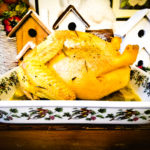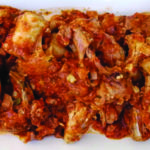STUFFED CAPON

Capon is a traditional Christmas bird in Europe. It is used either to make a very tasty but fat stock to accompany minestre, such as tortellini, or as a main course, usually stuffed. This stuffing is very simple. I had some cured meats leftover and I thought of giving them a second life. It is a very simple dish, and although there are other ways to cook it, for an Italian Christmas lunch, where there are also children who do not love exotic tastes and spices, this is the ideal cooking method.
Prep Time: 5 minutes | Cooking Time: 25 minutes | Total Time: 30 minutes | Yield: Makes 4 servings.
Ingredients
- 1 4lb (1.8 kg) capon, cleaned and trimmed
- Fine sea salt and freshly ground black pepper
For the stuffing
- 12.5 oz (350 g) ground pork and beef
- 3 oz (90 g) Emmental cheese
- 3 oz (90 g) rolled pancetta
- 3 eggs
- 2 potatoes, boiled and peeled
For cooking
- 2 garlic cloves
- ½ cup (125 ml) dry white wine
- 30 g butter
- 4 tbsps. olive oil
- 4 sage leaves
- A sprig of rosemary
- 2 ladles of chicken broth.
Instructions
Remove the giblets from the capon. Rinse out the cavity with cold water and pat it dry. Season it with salt and pepper.
Add all the ingredients to a food processor and mix. If you like the giblets, coarsely chop them and add to the stuffing.
Stuff the capon and sew the cavity. Put the capon in a big saucepan, brown the capon in butter and olive oil, with the aromatic herbs. Roast it for 20 minutes, then turn it on the other side and roast it for another 20 minutes. Add the wine and season with salt and black pepper to taste. Cook for two hours, basting and turning very carefully, to avoid the skin from breaking, adding some broth and cooking on a medium-low temperature.
To serve the capon, present it at the table whole, then carve it. Remove the stuffing in one piece if possible and slice it.

